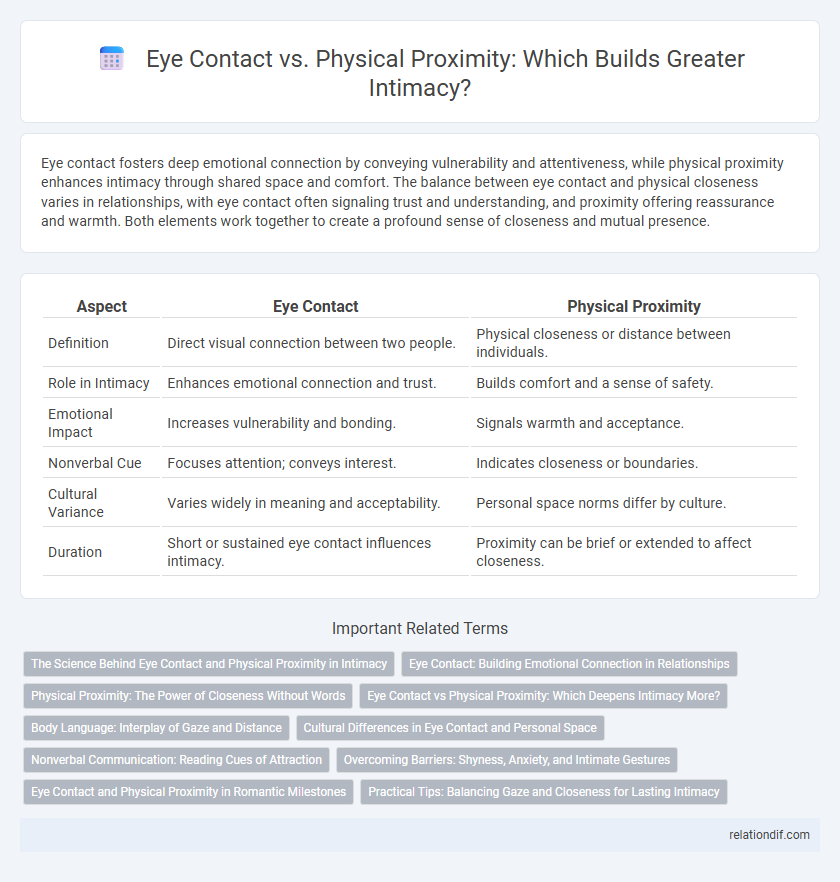Eye contact fosters deep emotional connection by conveying vulnerability and attentiveness, while physical proximity enhances intimacy through shared space and comfort. The balance between eye contact and physical closeness varies in relationships, with eye contact often signaling trust and understanding, and proximity offering reassurance and warmth. Both elements work together to create a profound sense of closeness and mutual presence.
Table of Comparison
| Aspect | Eye Contact | Physical Proximity |
|---|---|---|
| Definition | Direct visual connection between two people. | Physical closeness or distance between individuals. |
| Role in Intimacy | Enhances emotional connection and trust. | Builds comfort and a sense of safety. |
| Emotional Impact | Increases vulnerability and bonding. | Signals warmth and acceptance. |
| Nonverbal Cue | Focuses attention; conveys interest. | Indicates closeness or boundaries. |
| Cultural Variance | Varies widely in meaning and acceptability. | Personal space norms differ by culture. |
| Duration | Short or sustained eye contact influences intimacy. | Proximity can be brief or extended to affect closeness. |
The Science Behind Eye Contact and Physical Proximity in Intimacy
Eye contact activates the brain's social cognition networks, releasing oxytocin, which enhances emotional bonding and trust between partners. Physical proximity stimulates tactile receptors and the parasympathetic nervous system, promoting feelings of safety and attachment through the release of endorphins. Both eye contact and physical closeness are crucial in synchronizing nonverbal communication, strengthening intimacy by fostering neural and hormonal responses that deepen connection.
Eye Contact: Building Emotional Connection in Relationships
Eye contact plays a crucial role in building emotional connection by fostering trust and deepening intimacy between partners. Prolonged eye contact releases oxytocin, the bonding hormone, which strengthens feelings of closeness and empathy. Unlike physical proximity, eye contact directly engages the brain's social and emotional centers, enhancing mutual understanding and emotional resonance in relationships.
Physical Proximity: The Power of Closeness Without Words
Physical proximity conveys intimacy by bridging emotional gaps through mere presence, often communicating comfort and trust without uttering a single word. Studies show that closeness can trigger oxytocin release, enhancing bonding and feelings of security between individuals. Unlike eye contact, which demands direct attention, proximity allows for a shared space that fosters nonverbal connection and emotional warmth.
Eye Contact vs Physical Proximity: Which Deepens Intimacy More?
Eye contact creates a powerful nonverbal connection that fosters trust, vulnerability, and emotional closeness, often deepening intimacy more than mere physical proximity. While physical proximity signals comfort and safety, sustained eye contact engages the brain's emotional centers, enhancing feelings of bonding and understanding. Studies reveal that couples maintaining regular eye contact experience higher satisfaction and stronger emotional ties than those relying solely on closeness.
Body Language: Interplay of Gaze and Distance
Eye contact enhances intimacy by signaling attention and emotional connection, while physical proximity reinforces vulnerability and trust through shared personal space. The interplay of gaze and distance creates a dynamic body language dialog, where sustained eye contact combined with closer proximity deepens relational bonds. Understanding this nonverbal communication helps decode emotional closeness beyond spoken words.
Cultural Differences in Eye Contact and Personal Space
Cultural differences significantly influence both eye contact and personal space, where Western cultures often interpret direct eye contact as confidence and honesty, while many Asian and African societies may view prolonged eye contact as disrespectful or confrontational. Physical proximity preferences also vary; Latin American and Middle Eastern cultures typically embrace closer personal spaces during conversations, contrasting with Northern European and East Asian cultures that maintain greater distances to respect privacy. Understanding these variations is essential for fostering intimacy and effective communication across diverse cultural contexts.
Nonverbal Communication: Reading Cues of Attraction
Eye contact serves as a powerful nonverbal cue in signaling attraction, often conveying interest and emotional connection without words. Physical proximity complements this by indicating comfort and intimacy, with closer distances enhancing feelings of closeness and trust. Together, these cues create a nuanced language of attraction that relies on subtle body signals to communicate desire and engagement effectively.
Overcoming Barriers: Shyness, Anxiety, and Intimate Gestures
Eye contact plays a crucial role in overcoming barriers like shyness and anxiety by establishing a direct, non-verbal connection that fosters trust and emotional openness. Physical proximity, when approached gradually, enhances feelings of safety and comfort, helping partners share intimate gestures more naturally. Combining sustained eye contact with close presence encourages deeper emotional bonding and reduces the impact of social inhibitions during intimate moments.
Eye Contact and Physical Proximity in Romantic Milestones
Eye contact during romantic milestones enhances emotional connection by conveying sincerity and deepening intimacy without the need for physical touch. Maintaining steady eye contact can trigger the release of oxytocin, fostering trust and attachment between partners. Physical proximity complements this by creating a sense of safety and closeness, but eye contact remains a primary non-verbal cue that intensifies romantic bonding at key moments.
Practical Tips: Balancing Gaze and Closeness for Lasting Intimacy
Maintaining eye contact while respecting physical proximity enhances emotional connection and trust in intimate relationships. Practicing gradual increases in gaze duration paired with mindful closeness helps partners feel secure and valued without discomfort. Balancing these elements fosters deeper communication and lasting intimacy through nonverbal cues.
Eye contact vs physical proximity Infographic

 relationdif.com
relationdif.com